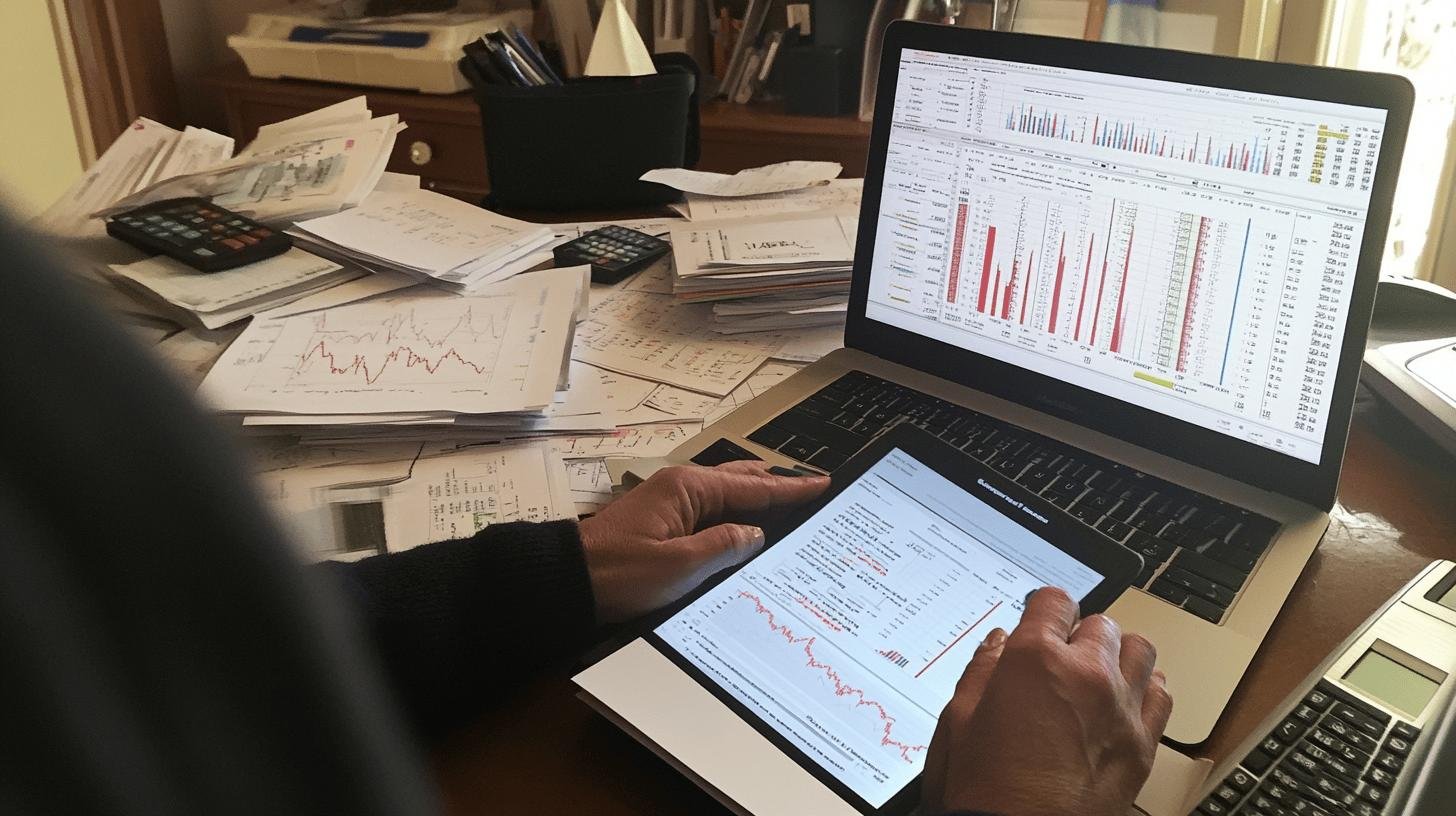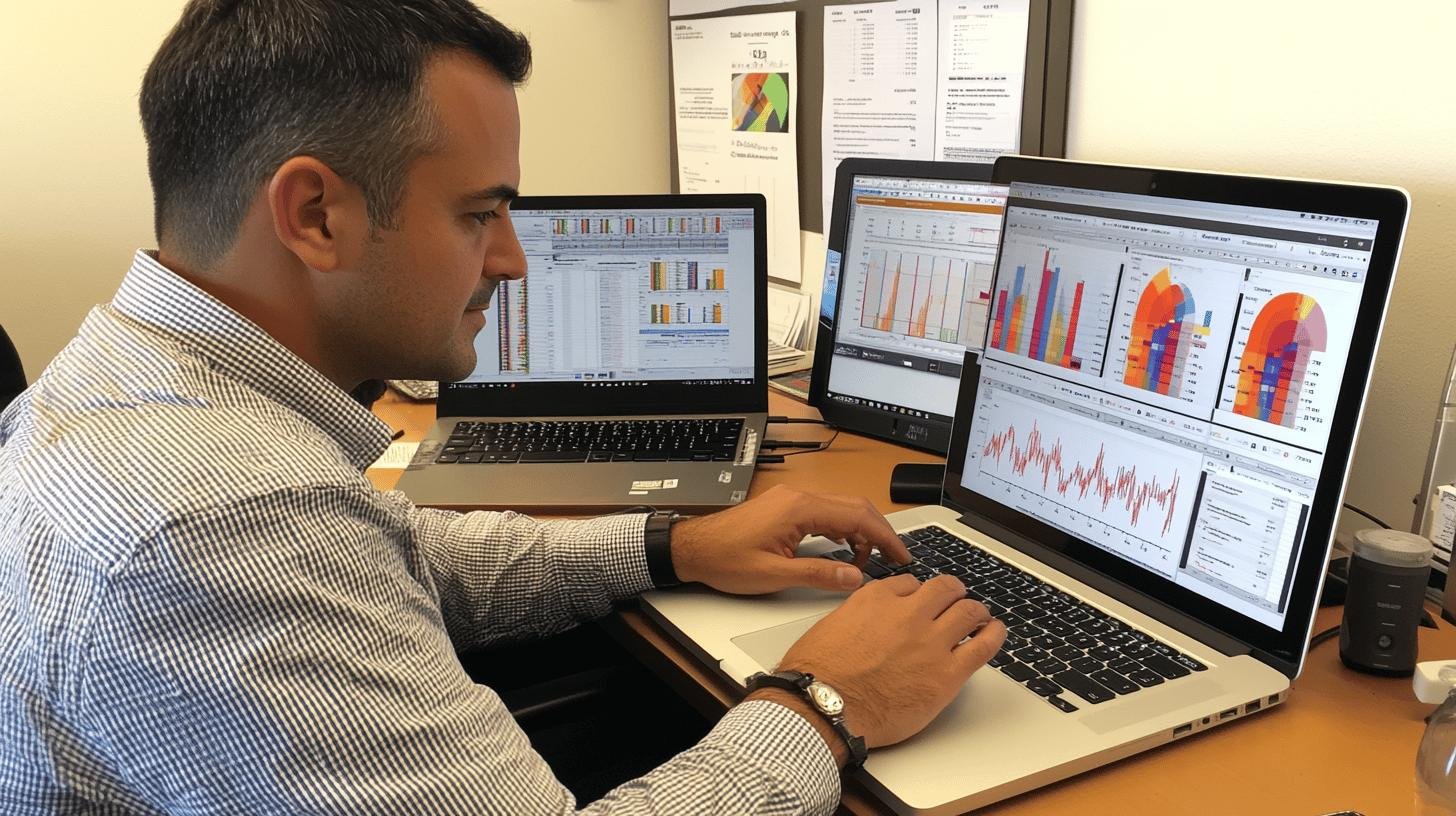Ever feel like your bank knows you better than you know yourself? That’s because financial services are shifting from just selling products to truly understanding customers, and it’s all thanks to analytics in financial services.
Data analytics is the secret sauce that turns mountains of information into helpful insights. It helps banks make smarter choices and keep customers satisfied. Curious how it all works? Let’s explore how analytics is transforming the financial world, putting you at the center!
The Role of Analytics in Financial Services
Why have financial services shifted from product-centric to customer-centric models? Because tech advancements have changed the game! 🚀
Data analytics in financial services helps organizations understand their customers better. It takes a mountain of data and turns it into actionable insights. This means banks can make smarter decisions, manage risks better, and keep customers happy. But how does this all work?
- Decision-Making: By analyzing customer behavior, banks can tailor services to meet specific needs. For example, if data shows that millennials prefer mobile banking, banks can focus more on app development.
- Risk Management: Analytics tools can predict potential risks by looking at past data. This helps in identifying fraud, managing credit risks, and ensuring compliance with regulations.
- Customer Satisfaction: Knowing what customers want before they do can improve their experience. Analytics helps in personalizing offers and services, making customers feel valued.
What makes analytics tools so crucial in financial services? They need to be super efficient at analyzing data and providing actionable insights. Without these tools, the data would just be a pile of numbers, useless and overwhelming.
Key Benefits of Data Analytics in Financial Services
- Actionable Insights: Transforming raw data into insights that can be used to make decisions.
- Enhanced Customer Focus: Understanding customer needs and tailoring services accordingly.
- Improved Risk Management: Identifying and mitigating potential risks before they become problems.
- Operational Efficiency: Streamlining processes by automating data analysis tasks.
Here’s a quick look at what banks achieve with analytics:
| Area | Benefit |
|---|---|
| Decision-Making | More informed choices based on data |
| Risk Management | Better fraud detection and risk mitigation |
| Customer Satisfaction | Personalized and improved services |
So, if you ever wondered why your bank knows exactly what you need, thank data analytics! 😊
Types of Analytics Used in Financial Services

Descriptive Analytics
Ever wondered how banks know what’s been happening with your money? They use descriptive analytics. This type of analytics looks at past data to find patterns and trends. Think of it like a history book for your finances. 📚
- Past Data Analysis: It takes all the transactions, account balances, and other data to show what happened.
- Trend Identification: Banks can see if there’s an increase in certain types of transactions, like online shopping during holidays.
- Pattern Recognition: By recognizing these patterns, banks can make sense of their past performance.
Predictive Analytics
Predictive analytics is like having a crystal ball 🔮. It uses historical data to make educated guesses about the future. This is super important for banks to plan ahead.
- Forecasting: Predictive analytics can forecast future trends, such as how many people will apply for loans next year.
- Behavior Prediction: It can guess what customers might do next, like whether they’ll want a new credit card.
- Risk Assessment: By looking at past data, banks can predict potential risks and take steps to avoid them.
Prescriptive Analytics
Prescriptive analytics goes one step further. It’s not just about seeing the past or guessing the future; it’s about making recommendations on what to do next. It’s like having a financial advisor who knows everything. 🤓
- Actionable Recommendations: Based on predictive models, it suggests actions, like which investments are safest.
- Optimal Solutions: It helps in finding the best solutions for complex problems, such as how to allocate funds.
- Decision Support: By providing these recommendations, it supports decision-making at all levels.
When you combine these types of analytics, you get a powerful toolkit for financial services. They help banks understand the past, predict the future, and make smart decisions. Here’s a quick look at what each type does:
| Type of Analytics | Function |
|---|---|
| Descriptive | Understand past data patterns |
| Predictive | Forecast future trends |
| Prescriptive | Provide actionable recommendations |
Successful Applications of Data Analytics in Financial Services
Fraud Detection
How do banks catch fraudsters? They use data analytics to keep your money safe. By analyzing transaction patterns, banks can spot unusual activities that might indicate fraud.
- Transaction Monitoring: Banks use analytics to monitor every transaction in real-time. If something looks fishy, like a sudden large withdrawal, it flags the activity for review.
- Behavior Patterns: Analytics helps in understanding normal behavior for each customer. If there’s a deviation, like someone using your card in another country while you’re at home, the system detects it.
- Machine Learning: Machine learning models get smarter over time. They learn from past fraud attempts and adjust to recognize new ones.
Risk Modeling
Banks need to manage risks to stay afloat. Risk modeling helps them understand potential pitfalls and plan accordingly.
- Investment Risks: By analyzing market trends and historical data, banks can predict which investments are risky. This helps in making safer investment choices.
- Credit Risks: Banks use risk models to evaluate the likelihood of a borrower defaulting on a loan. The models consider various factors, like credit scores and income levels, to make accurate predictions.
- Operational Risks: Banks also use analytics to identify risks in their operations. For example, they can spot inefficiencies in their processes and fix them before they cause problems.
Customer Service Enhancements
Ever chatted with a bank’s virtual assistant? That’s data analytics at work, making your life easier. 🗣️
- AI-Driven Chatbots: Chatbots use natural language processing to understand and respond to customer queries. They can handle routine questions, freeing up human agents for more complex issues.
- Virtual Assistants: These are more advanced than chatbots. They can help with tasks like checking account balances, transferring money, and even giving financial advice based on your spending habits.
- Personalized Marketing: Banks use data analytics to tailor marketing efforts. By understanding your preferences, they can offer you products and services that match your needs. Ever received a credit card offer just when you were thinking about getting one? That’s no coincidence!
Here’s a quick look at how banks use data analytics:
| Application | Benefit |
|---|---|
| Fraud Detection | Real-time monitoring and behavior pattern analysis |
| Risk Modeling | Predicting investment and credit risks |
| Customer Service | Enhanced interactions with AI-driven chatbots and virtual assistants |
So, the next time you feel safe banking online or get a spot-on financial recommendation, remember that data analytics is working behind the scenes! 😊
Tools and Software for Financial Data Analytics

When it comes to financial data analytics, having the right tools can make all the difference. So, what are some popular tools and software used in this field?
IBM’s Watson
IBM’s Watson is a powerhouse in financial predictive analytics. How does it help? Watson can analyze massive datasets in real-time, providing insights that help banks make quick decisions. It uses advanced AI to predict trends and identify risks. This means fewer surprises for banks and more accurate forecasting.
SAP’s HANA
SAP’s HANA is another favorite among financial data analytics companies. Why is it so popular? HANA offers real-time data processing, which is crucial for making timely decisions. It can handle large volumes of data and provide instant insights. This helps banks stay agile and responsive to market changes.
Oracle’s Financial Analytics
Oracle’s Financial Analytics is a go-to for many financial institutions. What makes it special? Oracle offers comprehensive risk assessment tools. These tools help banks evaluate potential risks and develop strategies to mitigate them. Plus, it integrates well with other software, making it easier to manage data from multiple sources.
Cloud Infrastructure
Why is cloud infrastructure so important? Cloud solutions offer scalability and efficiency. Banks can easily scale their data analytics operations up or down based on demand. This flexibility is essential for handling the fluctuating volumes of financial data. Plus, cloud-based solutions often come with built-in security features, ensuring data privacy and compliance.
Here’s a quick look at some popular tools and their key features:
| Tool | Key Features |
|---|---|
| IBM’s Watson | Real-time data analysis, predictive modeling |
| SAP’s HANA | Real-time data processing, large data handling |
| Oracle’s Financial Analytics | Risk assessment, data integration |
So, whether it’s real-time processing with HANA, predictive insights with Watson, or risk management with Oracle, these tools are essential for modern financial services. They help banks make smarter decisions, manage risks, and keep up with the fast-paced financial world. 🚀
Current Trends in Financial Data Analytics
How has the pandemic changed customer data and touchpoints?
The pandemic has significantly altered customer data and touchpoints. It has driven more people to use digital banking services, creating a surge in online transactions. This shift requires new data models to understand these digital behaviors better.
- Increase in Online Transactions: More people are banking online, which means more data to analyze.
- New Customer Touchpoints: With fewer in-person interactions, banks now gather data from apps, websites, and virtual assistants.
What is augmented analytics, and why is it rising?
Augmented analytics uses AI (Artificial Intelligence) and ML (Machine Learning) to enhance data analysis. This trend is rising because it makes complex data easier to understand and actionable.
- AI and ML Integration: These technologies help in identifying patterns and making predictions more accurately.
- User-Friendly Insights: Augmented analytics tools provide insights that are easier for non-data experts to understand.
Why is there an increasing focus on data privacy and security?
Data privacy and security are becoming more critical as banks handle more sensitive information. Regulatory bodies require stricter compliance, and customers demand better protection of their data.
- Regulatory Compliance: Laws like GDPR and CCPA require banks to follow strict data protection guidelines.
- Customer Trust: Ensuring data privacy helps in building and maintaining customer trust.
Here’s a quick look at the current trends:
| Trend | Impact |
|---|---|
| Pandemic’s Impact | New data models to handle digital behaviors |
| Augmented Analytics | Enhanced data analysis using AI and ML |
| Data Privacy & Security | Stricter compliance and customer trust |
So, with these trends, the financial world is adapting to new challenges and technologies, making data analytics more crucial than ever. 🚀
Best Practices for Implementing Analytics in Financial Services

Why is data integration crucial? Integration of data from multiple channels ensures that banks have a complete picture of their operations and customer behavior. Without this integration, important insights could be missed.
- Comprehensive View: Combining data from branches, online platforms, and customer service centers provides a 360-degree view.
- Improved Decision-Making: Integrated data helps in making more informed decisions, as all relevant information is considered.
- Consistency: It ensures that the data is consistent across various departments, reducing errors and discrepancies.
How do you maintain data quality? Ensuring data quality is vital for accurate analytics. Poor data quality can lead to incorrect insights and bad decisions.
- Data Cleaning: Regularly cleaning data to remove duplicates and errors is essential.
- Validation: Implementing validation rules to ensure that data entries are accurate and complete.
- Continuous Monitoring: Keeping an eye on data quality metrics to catch issues early.
Why focus on actionable insights? The goal of data analytics is to provide insights that can be acted upon. If the insights are not actionable, they are of little use.
- Relevance: Focus on insights that directly impact business goals, like increasing customer satisfaction or reducing risks.
- Clarity: Presenting insights in a clear and understandable manner helps in quick decision-making.
- Timeliness: Providing timely insights ensures that decisions are made at the right moment.
What does Goldman Sachs do for data compliance? The governance and quality team at Goldman Sachs ensures data compliance and high standards. This involves strict policies and regular audits to make sure all data practices meet regulatory requirements.
- Regulatory Compliance: Adhering to laws and regulations like GDPR and CCPA.
- Internal Audits: Conducting regular audits to ensure that data practices are up to the mark.
- Training: Regularly training employees on data handling and compliance practices.
Here’s a quick look at these best practices:
| Best Practice | Benefit |
|---|---|
| Data Integration | Provides a comprehensive view and improves decision-making |
| Data Quality | Ensures accurate analytics and reliable insights |
| Actionable Insights | Directly impacts business goals and enhances decision-making |
| Data Compliance | Ensures regulatory adherence and high standards |
By following these best practices, financial services can effectively implement analytics to drive better decision-making and enhance customer experiences. 😊
How Analytics Improves Decision-Making and Reduces Risk
How does data analytics help in risk assessment? By analyzing past transactions and market trends, banks can predict future risks with greater accuracy.
- Risk Assessment: Banks can identify potential defaulters by looking at credit history and spending patterns. This helps in taking preventive measures before things go south.
How can banks create strategies to reduce losses? With data analytics, banks can develop targeted strategies to mitigate risks.
- Loss Mitigation Strategies: Analytics can suggest tailored strategies for different types of risks. For instance, if there’s a high likelihood of loan defaults in a certain segment, banks can tighten lending criteria for that group.
How does Goldman Sachs use data engineering to enhance decision-making and risk reduction? Goldman Sachs leverages data engineering to streamline data processes and ensure high-quality data for better decision-making.
- Data Engineering: By organizing and cleaning data efficiently, Goldman Sachs ensures that the data used for analytics is reliable. This leads to more accurate risk assessments and better decisions.
Let’s break down how these techniques are applied in real life:
| Technique | Application | Benefit |
|---|---|---|
| Data Analysis | Analyzing past transactions and trends | Accurate risk predictions |
| Loss Mitigation | Creating targeted strategies | Reduced financial losses |
| Data Engineering | Organizing and cleaning data | Better decision-making |
How does risk management data analytics play a role? Risk management data analytics helps banks identify and manage various risks, from credit to operational risks.
- Credit Risks: By analyzing credit scores and financial behavior, banks can predict the likelihood of defaults and adjust their lending practices.
- Operational Risks: Analytics can spot inefficiencies and potential failures in banking operations, allowing for preemptive actions.
How does financial risk mitigation analytics work? It uses historical data to develop models that predict potential risks and suggest mitigation strategies.
- Predictive Modeling: These models can forecast market downturns, helping banks prepare in advance.
- Proactive Measures: With these insights, banks can take proactive steps like diversifying portfolios or adjusting interest rates.
With these analytics techniques, financial institutions can make well-informed decisions, reducing risks and driving better outcomes for everyone involved. 😊
Enhancing Customer Experience Through Analytics

How do banks use analytics for personalized marketing? By analyzing customer data, banks can tailor their marketing efforts to individual needs. This means you get offers and services that truly match your preferences.
- Personalized Offers: Using data analytics, banks can identify what products you might be interested in and send targeted promotions.
- Better Engagement: Personalized marketing leads to higher engagement because the offers are relevant to you.
How does lifetime value prediction work? Lifetime value prediction estimates how much profit a customer will bring over time. It helps banks focus on retaining valuable customers.
- Customer Retention: By knowing which customers are most valuable, banks can create strategies to keep them happy and loyal.
- Profit Maximization: Banks can allocate resources more effectively, focusing on high-value customers.
What are recommendation engines? Recommendation engines suggest products or services based on your past behavior. Think of it like Netflix recommendations but for banking services.
- Tailored Suggestions: If you’ve recently taken out a mortgage, the bank might suggest home insurance.
- Increased Satisfaction: By offering relevant products, banks make your life easier, boosting overall satisfaction.
Saxon’s Marketing Desk simplifies complex data to better understand customer behavior. This helps in providing more personalized services.
- Simplified Data: By making data more understandable, banks can quickly identify trends and preferences.
- Enhanced Service: Better data understanding leads to more accurate recommendations and improved customer service.
Here’s how analytics enhances customer experience:
| Application | Benefit |
|---|---|
| Personalized Marketing | Tailored offers and better engagement |
| Lifetime Value Prediction | Improved customer retention and profit maximization |
| Recommendation Engines | Relevant product suggestions and increased satisfaction |
So, the next time you get a spot-on financial offer, know that data analytics is working behind the scenes to make your experience better. 😊
Final Words
We jumped right into how analytics in financial services has become a game-changer. The shift to a customer-centric approach is driven by efficient data analysis, helping banks and financial firms make smarter decisions.
From descriptive to prescriptive analytics, each type has its perks. We’ve seen real-world examples like fraud detection and AI chatbots enhancing customer service.
Key tools and software, such as IBM’s Watson and SAP HANA, are vital for effective data analysis. And let’s not forget, current trends like augmented analytics are all the buzz.
So, next time you think about financial services, remember how crucial analytics are for decision-making and improving customer experiences. Keep riding the wave of innovation! For more insights, visit WikiWayne.
FAQs
What’s the average salary for a Financial Data Analyst?
The average salary for a Financial Data Analyst in the U.S. is around $80,000 per year. It can vary based on experience, location, and the company’s size.
Can you share some examples of analytics in financial services?
Analytics in financial services includes fraud detection, risk modeling, credit risk analysis, personalized marketing, and operational risk management. AI-driven chatbots also improve customer service.
What are the main types of analytics used in financial services?
The main types are descriptive analytics (understanding past data), predictive analytics (forecasting future trends), and prescriptive analytics (providing actionable recommendations).
Can you give examples of how data analytics is used in finance?
Banks use data analytics for detecting fraud, managing credit risks, personalizing customer interactions, and optimizing investment portfolios.
What are some real-world examples of financial analytics?
Real-world examples include using predictive models to forecast market trends, AI for fraud detection, and analytics tools for customer segmentation.
Are there any courses for becoming a Financial Data Analyst?
Yes, there are many online courses like those on Coursera and edX that cover financial data analysis, including programming in Python and using tools like Excel.




